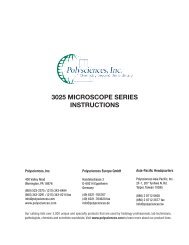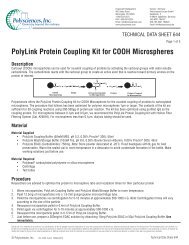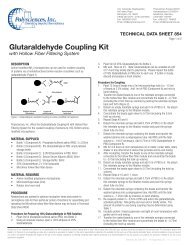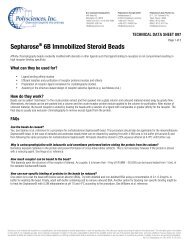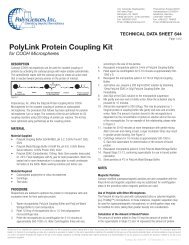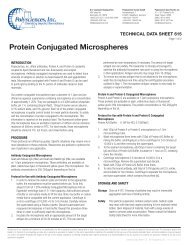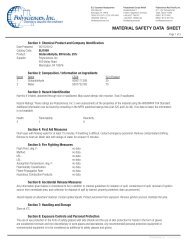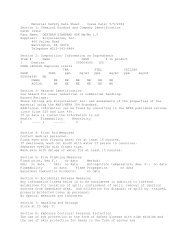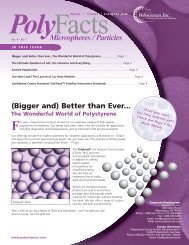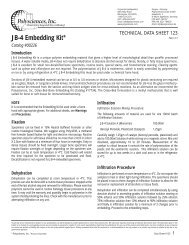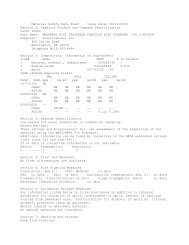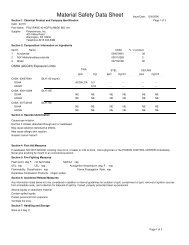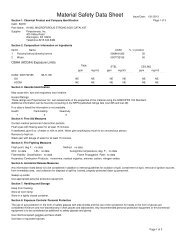Size Calibration Standards Kit - Polysciences, Inc.
Size Calibration Standards Kit - Polysciences, Inc.
Size Calibration Standards Kit - Polysciences, Inc.
You also want an ePaper? Increase the reach of your titles
YUMPU automatically turns print PDFs into web optimized ePapers that Google loves.
Product Data Sheet 829 <strong>Size</strong> <strong>Calibration</strong> <strong>Standards</strong> <strong>Kit</strong><br />
9025 Technology Dr. • Fishers, IN 46038-2886<br />
800.387.0672 • 317.570.7020 • Fax 317.570.7034<br />
info@bangslabs.com • www.bangslabs.com<br />
B E A D S A B O V E T H E R E S T <br />
Description<br />
The <strong>Size</strong> <strong>Calibration</strong> <strong>Standards</strong> <strong>Kit</strong> contains 5 populations of unstained microsphere standards of different sizes. The standards are<br />
suspended in a sterile, filtered, isotonic buffered solution containing a surfactant and a preservative. Each bottle contains microspheres<br />
at a concentration of 2 x 10 6 particles/mL. The <strong>Size</strong> <strong>Calibration</strong> <strong>Standards</strong> <strong>Kit</strong> is to be used to construct calibration plots for electronic<br />
volume and light scatter instrumentation.<br />
Characteristics<br />
Mean Diameter:<br />
Particle Concentration:<br />
4-11µm<br />
2 x 10 6 particles/mL<br />
Material<br />
Material Supplied<br />
• <strong>Size</strong> <strong>Calibration</strong> <strong>Standards</strong> <strong>Kit</strong>: 5 populations<br />
Material Required<br />
• Isotonic phosphate saline (pH 7.2)<br />
• Appropriate sized tubes<br />
• Flow cytometer<br />
Procedure<br />
Researchers are advised to optimize the use of particles in any application.<br />
The <strong>Size</strong> <strong>Calibration</strong> <strong>Standards</strong> <strong>Kit</strong> is to be used to construct calibration plots for electronic volume and light scatter instrumentation.<br />
Factors which compensate for the difference in refractive indices between the microsphere standards and biological cells need to be<br />
used. These factors can be derived by measuring a cell of known size (by scanning electron microscopy), e.g. a lymphocyte, on the<br />
calibration plot and determining the difference between the known size and its measured size, and using this number as a correction<br />
factor in subsequent size determinations. This correction factor can be employed by horizontally shifting the calibration plot to where<br />
the cell should have fallen on the plot. Note that fixation may significantly change the refractive index of cellular components and thus<br />
affect the light scatter properties of the cell as a whole.<br />
On the other hand, when using an electronic volume sensing instrument, hydrodynamic shape factors must be considered. That<br />
is, only cells which are spherical, such as lymphocytes, may have their size directly determined against the calibration plot derived<br />
from spherical microsphere standards. In the case of measuring the size of erythrocytes, which have a concave disk shape, the<br />
measured value will appear lower than expected and the hydrodynamic factor of 1.5 must be used to multiply the reading from the<br />
volume calibration plot for an accurate size determination of these cells. A more complete discussion of such hydrodynamic factors is<br />
presented by V. Kachel. 1<br />
A size calibration plot for a flow cytometer may be generated by plotting the relative channel number (linear or log) of the peak<br />
maximum against the appropriate size value of the microsphere standards. A linear relationship may be obtained from a log-log plot<br />
if a linear amplifier is used. Plotting data from linear amplifiers on log-log paper has the advantage of not only conveniently extending<br />
the range over which measurements can be made, but it also reduces all the size parameters to linear relationships. When using a log<br />
Bangs Laboratories, <strong>Inc</strong>. Product Data Sheet 829 Rev. #006, Active: 09/December/2009 ><br />
Page 1 of 3
Product Data Sheet 829<br />
amplifier, a linear relationship is obtainable if the plot is made on semi-log paper. Linear relationships for all these size parameters are<br />
obtained when plotted as suggested, because the above equations are transformed into log expressions with the power of the diameter<br />
converted to relative slope of the relationship, as follows:<br />
Diameter = log (D)<br />
Cross-sectional Area = 2 log (D) + log (π/4)<br />
Surface Area = 2 log (D) + log (π)<br />
Volume = 3 log (D) + log (π/6)<br />
This method of data representation allows multiple-size calibration (i.e., diameter, cross-sectional area, surface area, and volume) to be<br />
plotted as linear functions on the same graph, or linear and log amplifier, respectively. With these simultaneous calibration plots, the<br />
operator is able to directly determine all size parameters just by knowing the peak maximum channel number of the sample. 2<br />
Caution: <strong>Size</strong> Interpretation<br />
Having a graduated series of uniform microspheres to calibrate the size channel of a flow cytometer can be useful when considering<br />
cellular sample sizes; however, additional factors must be considered. When sizing samples by light scatter, the refractive index is<br />
an important factor in the measurement. Although forward scatter is not as sensitive to differences in refractive index as 90˚ scatter,<br />
differences in refractive index between the microsphere standards and cellular samples can affect size measurements. 3<br />
Although the FSC detector of flow cytometers will provide some indication of bead or cell size, it is important to note that cytometers<br />
are not sizers, per se, and do not afford the same accuracy and resolution as dedicated sizing instruments. FSC amplitude is not a<br />
monotonic function of particle size, and FSC response may also vary by instrument make and model, i.e. with different optical systems.<br />
Considerations in <strong>Size</strong> Determination of Samples<br />
The term “size” in this document refers not only to the diameter of the microscope or cell, but also to other size parameters, including<br />
the cross-sectional area, the surface area, and the volume. Accurate determination of any of these size parameters by means of a flow<br />
cytometer is not as straight-forward as it may seem. 4<br />
For example, it is important to remember which sizing parameters are being measured by the instrument. With flow cytometers that<br />
have volume sensors, one cannot simply plot the diameter of the microsphere standards against the relative peak channel on a linear<br />
scale and expect to obtain a straight line. Instead, the volume of each microsphere would have to be calculated from a given diameter<br />
first, and then that volume would be plotted against the relative channel number to obtain a straight line. Similarly, with instruments<br />
that have light scatter detectors, the cross-sectional area is the parameter that is being measured, and therefore the one that should be<br />
plotted. As a convenience, the size formulae as a function of diameter are presented below:<br />
Diameter = D<br />
Cross-sectional Area = πD 2 /4<br />
Surface Area = πD 2<br />
Volume = πD 3 /6<br />
<strong>Size</strong> <strong>Calibration</strong><br />
1. Bath sonicate for 30 seconds or vigorously shake the bottle to ensure uniform suspension of standard.<br />
2. Add 1 drop of each of the 5 sized beads into isotonic phosphate saline (pH 7.2).<br />
3. Run the beads. Note: When establishing a calibration plot, make no further adjustments to the instrument once you have begun<br />
collecting data.<br />
4. Determine the FSC Peak Channel Number for each population.<br />
5. Plot the diameter, surface area, or volume (y-axis) vs. the Peak Channel (x-axis) for the 5 sized beads<br />
Expected Value<br />
A generally linear relationship should be obtained when the five populations are plotted. FSC response may vary by instrument make<br />
and model, i.e., with different optical systems.<br />
Bangs Laboratories, <strong>Inc</strong>. Product Data Sheet 829 Rev. #006, Active: 09/December/2009<br />
><br />
Page 2 of 3
Product Data Sheet 829<br />
References<br />
1. Kachel, V. 1979. Electronic resistance pulse sizing (Coulter sizing). In: M.R. Melamed, ed., Flow cytometry and sorting. New York:<br />
Wiley & Sons, Ltd., pp. 61-104.<br />
2. Schwartz, A., H. Sugg, T.W. Ritter, E. Fernandez-Repollet. 1983. Direct determination of cell diameter, surface area, and volume<br />
with an electronic volume sensing flow cytometer. J Cytomet, 3(6):456-458.<br />
3. Salzman, G.C. 1982. Light scattering of single cells. In: N. Catsimpoolas, ed. Cell analysis, Vol. 1. New York: Plenum Publishing<br />
Corp., pp. 111-143.<br />
4. Shapiro, H.M. 1988. Practical flow cytometry. New York: Wiley-Liss.<br />
Storage and Stability<br />
Store at 2-8˚C. Freezing of particles may result in irreversible aggregation and loss of binding activity. Stable for 12 months from date of<br />
purchase, provided the product is handled in accordance with the manufacturer’s recommendations. Specifically, the reagent should be<br />
kept in its opaque bottle.<br />
Safety<br />
This particle suspension contains sodium azide. Sodium azide may react with lead and copper plumbing to form explosive metal azides.<br />
Upon disposal of material, flush with a large volume of water to prevent azide accumulation. Please consult the Material Safety Data<br />
Sheet for more information.<br />
This product is for research use only and is not intended for use in humans or for in vitro diagnostic use.<br />
Ordering Information<br />
Catalog Code Description <strong>Size</strong>s<br />
829 <strong>Size</strong> <strong>Calibration</strong> <strong>Standards</strong> <strong>Kit</strong> 5mL or 14mL<br />
Order online anytime at www.bangslabs.com.<br />
Bangs Laboratories, <strong>Inc</strong>. Product Data Sheet 829 Rev. #006, Active: 09/December/2009 ><br />
Page 3 of 3



